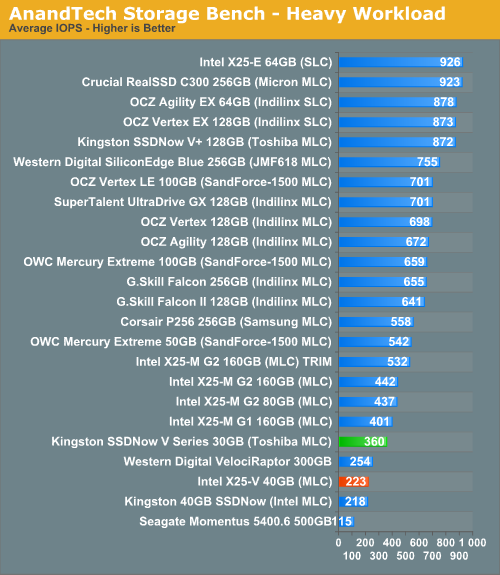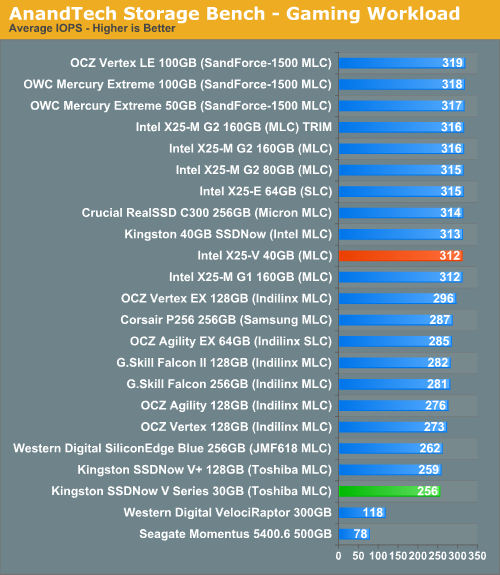Intel's X25-V & Kingston's 30GB SSDNow V Series: Battle of the $125 SSDs
by Anand Lal Shimpi on March 19, 2010 12:00 AM EST- Posted in
- Storage
AnandTech Storage Bench
Note that our 6Gbps controller driver isn't supported by our custom storage bench here, so the C300 results are only offered in 3Gbps mode.
The first in our benchmark suite is a light usage case. The Windows 7 system is loaded with Firefox, Office 2007 and Adobe Reader among other applications. With Firefox we browse web pages like Facebook, AnandTech, Digg and other sites. Outlook is also running and we use it to check emails, create and send a message with a PDF attachment. Adobe Reader is used to view some PDFs. Excel 2007 is used to create a spreadsheet, graphs and save the document. The same goes for Word 2007. We open and step through a presentation in PowerPoint 2007 received as an email attachment before saving it to the desktop. Finally we watch a bit of a Firefly episode in Windows Media Player 11.
There’s some level of multitasking going on here but it’s not unreasonable by any means. Generally the application tasks proceed linearly, with the exception of things like web browsing which may happen in between one of the other tasks.
The recording is played back on all of our drives here today. Remember that we’re isolating disk performance, all we’re doing is playing back every single disk access that happened in that ~5 minute period of usage. The light workload is composed of 37,501 reads and 20,268 writes. Over 30% of the IOs are 4KB, 11% are 16KB, 22% are 32KB and approximately 13% are 64KB in size. Less than 30% of the operations are absolutely sequential in nature. Average queue depth is 6.09 IOs.
The performance results are reported in average I/O Operations per Second (IOPS):

Intel's X25-V performs virtually identically to the older Kingston 40GB Boot Drive. The new 30GB drive does have the advantage though, performing much more like an Indilinx drive than a scaled down X25-M thanks to its higher sequential write speed.
If there’s a light usage case there’s bound to be a heavy one. In this test we have Microsoft Security Essentials running in the background with real time virus scanning enabled. We also perform a quick scan in the middle of the test. Firefox, Outlook, Excel, Word and Powerpoint are all used the same as they were in the light test. We add Photoshop CS4 to the mix, opening a bunch of 12MP images, editing them, then saving them as highly compressed JPGs for web publishing. Windows 7’s picture viewer is used to view a bunch of pictures on the hard drive. We use 7-zip to create and extract .7z archives. Downloading is also prominently featured in our heavy test; we download large files from the Internet during portions of the benchmark, as well as use uTorrent to grab a couple of torrents. Some of the applications in use are installed during the benchmark, Windows updates are also installed. Towards the end of the test we launch World of Warcraft, play for a few minutes, then delete the folder. This test also takes into account all of the disk accesses that happen while the OS is booting.
The benchmark is 22 minutes long and it consists of 128,895 read operations and 72,411 write operations. Roughly 44% of all IOs were sequential. Approximately 30% of all accesses were 4KB in size, 12% were 16KB in size, 14% were 32KB and 20% were 64KB. Average queue depth was 3.59.

Crank up the sequential writes and Kingston's lead grows. The 30GB V series drive almost performs like an X25-M G1 in this case. The X25-V on the other hand performs more like a low latency VelociRaptor. Still better than a hard drive, but don't expect to copy files any faster.
The gaming workload is made up of 75,206 read operations and only 4,592 write operations. Only 20% of the accesses are 4KB in size, nearly 40% are 64KB and 20% are 32KB. A whopping 69% of the IOs are sequential, meaning this is predominantly a sequential read benchmark. The average queue depth is 7.76 IOs.

With both Intel and Kingston equal in sequential read performance, the differentiating factor here is strictly random read performance where the X25-V has the edge.










78 Comments
View All Comments
jed22281 - Saturday, March 27, 2010 - link
Given it's in a similar size category...Shouldn't the 50GB OWC Mercury Extreme be included in this?
Or is it only allowed to sit in X25-M territory?
Is that the only other competitor for the Mercury Extreme?
If true...
In which scenario/s might one pick the Extreme over the X25-M?
Thank-you!
thllxb - Saturday, March 27, 2010 - link
I actually bought one intel-v 40g and i got the shipment today. The sequential read is very good, 190mb/s with nvidia SATA controller driver and 170mb/s with win7 driver. However, the random read speed is only 22mb/s with both drivers, much lower than the test result 60mb/s. I still need to find out why.jed22281 - Friday, March 26, 2010 - link
Given it's in a similar size category...Shouldn't the 50GB OWC Mercury Extreme be included in this?
Or is it only allowed to sit in X25-M territory?
Is that the only other competitor for the Mercury Extreme?
If true...
In which scenario/s might one pick the Extreme over the X25-M?
Thank-you!
jed22281 - Thursday, March 25, 2010 - link
^^^ anyone? thank-you!jed22281 - Thursday, March 25, 2010 - link
^^^ anyone? thank-you!jed22281 - Wednesday, March 24, 2010 - link
Given it's in a similar size category...Shouldn't the 50GB OWC Mercury Extreme be included in this?
Or is it only allowed to sit in X25-M territory?
Is that the only other competitor for the Mercury Extreme?
If true...
In which scenario/s might one pick the Extreme over the X25-M?
Thank-you!
NandFlashGuy - Sunday, March 21, 2010 - link
Hi Anand,I think it's misleading that you continue using the phrase "IMFT Nand". This gives the impression that all IMFT Nand is equivalent.
IMFT does not sell Nand -- they are the just legal way that Micron and Intel can share the cost of manufacturing Nand together. Each parent company has the ability to define their own litho process or their own test strategies.
This means that the Nand on the X-25 series is "Intel Nand", not IMFT or Micron Nand. Moreover, the Nand on the X-25 series receives much more extensive testing than what is sold to the removable memory market.
chuckbam - Saturday, March 20, 2010 - link
Because of the growth size of the winsxs folder, I think 40GBs are to small for a boot drive.sdsdv10 - Sunday, March 21, 2010 - link
That might be the case for you, but not for everyone. I just upgraded my father-in-law's PC with one of the Intel 40GB SSD and a 250GB regular HD for data storage. Installation of Windows 7 Home Premium left just under 23GB of usable space. Besides IE, the only other thing he needed was Office 2003 (this took less than 350MB total). Still had 22GB of space left. It boots up very quick and opening programs in very fast (nearly instantaneous). A nice improvement over the previous incarnation with XP on a regular 7200rpm HD.JimmiG - Saturday, March 20, 2010 - link
28 or 37GB is definitely too small for me. If you're going to buy a SSD to speed things up, there must be enough space on it to actually install some stuff on it to speed up. If you can only speed up a few percent of your disk operations, it's pretty pointless.60GB would be the minimum for me, preferably 80+ GB. 30GB is barely enough for Win7 itself *or* a couple of games. I'm using 410GB on my "Applications" drive, the one that contains the OS and games and programs I use (almost no user data like movies or pictures).